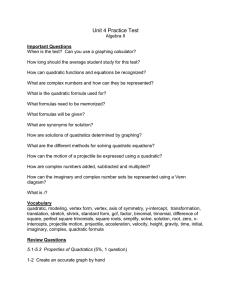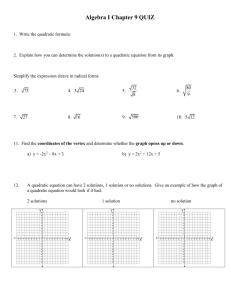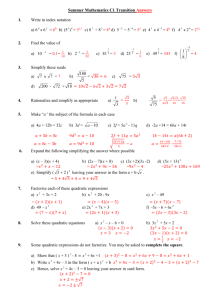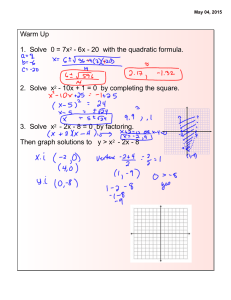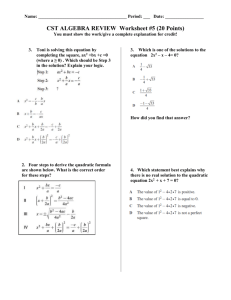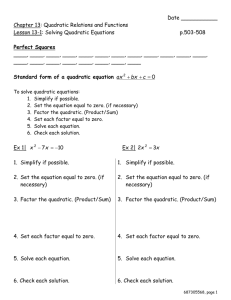Travis High School Daily Lesson Planning Template Department
advertisement
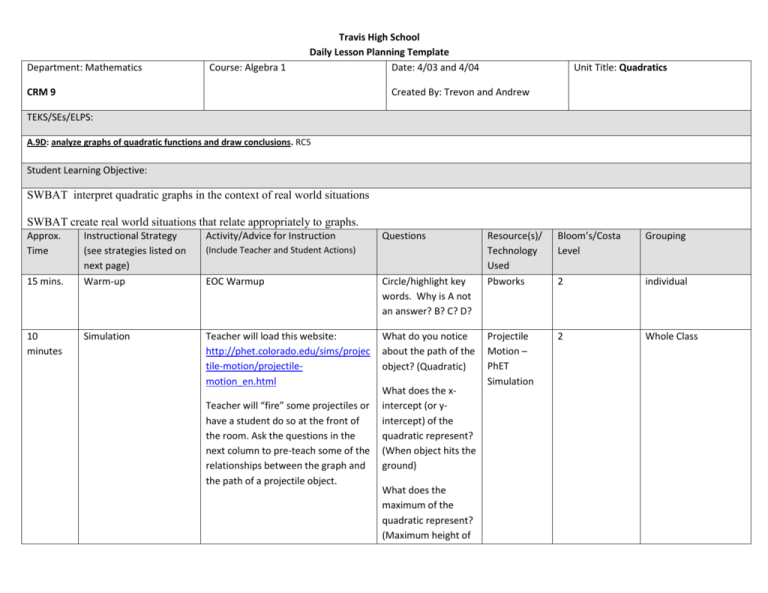
Department: Mathematics Course: Algebra 1 Travis High School Daily Lesson Planning Template Date: 4/03 and 4/04 CRM 9 Unit Title: Quadratics Created By: Trevon and Andrew TEKS/SEs/ELPS: A.9D: analyze graphs of quadratic functions and draw conclusions. RC5 Student Learning Objective: SWBAT interpret quadratic graphs in the context of real world situations SWBAT create real world situations that relate appropriately to graphs. Approx. Time 15 mins. 10 minutes Instructional Strategy (see strategies listed on next page) Warm-up Activity/Advice for Instruction Questions EOC Warmup Circle/highlight key words. Why is A not an answer? B? C? D? Simulation Teacher will load this website: http://phet.colorado.edu/sims/projec tile-motion/projectilemotion_en.html What do you notice about the path of the object? (Quadratic) (Include Teacher and Student Actions) Teacher will “fire” some projectiles or have a student do so at the front of the room. Ask the questions in the next column to pre-teach some of the relationships between the graph and the path of a projectile object. What does the xintercept (or yintercept) of the quadratic represent? (When object hits the ground) What does the maximum of the quadratic represent? (Maximum height of Resource(s)/ Technology Used Pbworks Bloom’s/Costa Level Grouping 2 individual Projectile Motion – PhET Simulation 2 Whole Class the object) 30 minutes Cooperative Learning Students will work on different parts of the activity (evenly distribute Martin, Pamela, and Nathan). Students can work with others that have the same person. If students finish early they can help other groups or do a analyze a different person’s graph. Students will be responsible for presenting their information to the class. 20 mins Writing Students will receive a quadratic equation with a negative “a” and positive “c” value. First they will have to sketch the graph. Then they will have to write a real world situation to match the graph (REMIND THEM TO FOCUS ON QUADRANT 1). If students finish early, have them switch equations. What height was their ball thrown from? How long did it take their ball to hit the ground? CW_The Way the Ball Bounces Worksheets 3 Groups CW_Real World Situations 3 Groups Exit Slip 2 Individual At what time(s) was the person’s ball at ___ height? How long was the ball above _____ height? Which part of the graph do you need to focus on? (Quadrant 1) What does the xintercept represent? What does the vertex represent? What does the yintercept represent? How long was your object in the air? 15 mins. Exit Slip Quiz Students will complete the “Evaluate” questions. Homework HW_Real World Quads HW_Real World Quads Instructional Strategies: Card Sort Choral Response Cooperative Learning Cornell Notes Exit Slips Four Corners Gallery Walk Groups Independent Problem Solving Independent Projects Interactive Manipulatives Journals Lab Studio Learning Logs or Walks Line Ups Philosophical Sticks/Random Pictionary Quick Writes Role Play Scavenger Hunt Skits Socratic Seminar Stations Think Alouds Think-Pair-Share Warm up White Board Check-ins Other Travis High School Daily Lesson Planning Template Modifications/ Accommodations: Teacher feedback/reflection on lesson plan Remember 4 Questions: Non Negotiables 1) What do we want students to learn? What should each student know and be able to do after each unit? 2) How will we consistently know if the students have learned the standard? 3) What will we do if the students are not proficient in the standards? What process is in place to provide additional time and support for students who are experiencing difficulty? 4) What will we do if they already mastered the standard? * Incorporate reading and writing strategies in each lesson plan * Objectives need to be posted and able to be read by students and staff * Limit direct teach * Varied instructional strategies * Higher level questions * Bell-to-bell instruction



